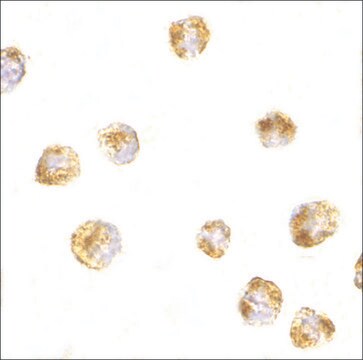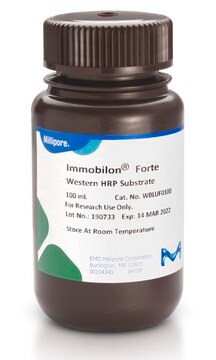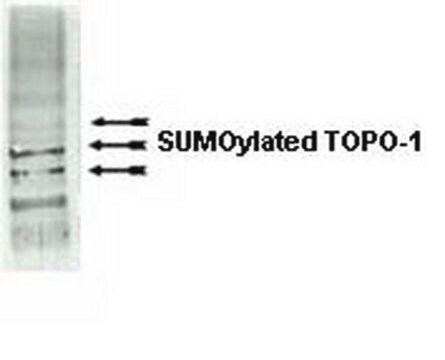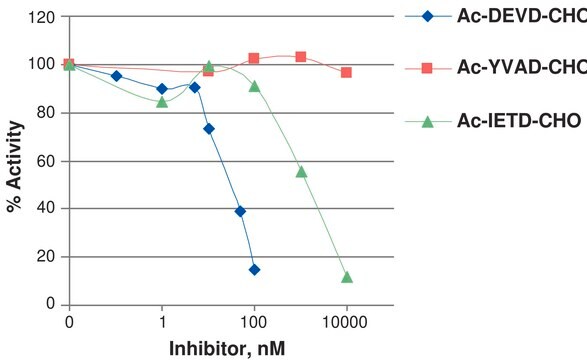추천 제품
생물학적 소스
mouse
Quality Level
항체 형태
purified immunoglobulin
항체 생산 유형
primary antibodies
클론
8A2, monoclonal
종 반응성
human
포장
antibody small pack of 25 μg
기술
immunocytochemistry: suitable
immunoprecipitation (IP): suitable
western blot: suitable
동형
IgG2bκ
NCBI 수납 번호
배송 상태
ambient
타겟 번역 후 변형
unmodified
유전자 정보
human ... SUMO2(6613)
일반 설명
Small ubiquitin-related modifier 2 (UniProt P61956; also known as HSMT3, Sentrin-2, SMT3 homolog 2, Smt3B, SUMO-2, Ubiquitin-like protein SMT3B) and 3 (UniProt P55854; also known as SMT3 homolog 1, Smt3A, SUMO-3, Ubiquitin-like protein SMT3A) are encoded by the SUMO2 (also known as SMT3B, SMT3H2; Gene ID 6613) and SUMO3 (also known as SMT3A, SMT3H1; Gene ID 6612) genes in human. SUMOylation, protein post-translation modification by small ubiquitin-like modifier (SUMO), is a signaling event in many cellular processes. SUMO proteins are translated as immature precursors and subsequently converted to their mature forms through the activity of sentrin/SUMO-specific proteases (SENPs). SUMOylation is a reversible process. SUMO E1 activating enzyme, E2 conjugating enzyme, and E3 ligase mediate SUMOylation of substrate proteins, while SENPs are responsible for the de-SUMOylation. SUMOylation usually occurs at lysine residues in the consensus KxD/E motif, although not all such lysines become SUMOylated and SUMOylation can also occur on lysine residues outside of this motif. SUMO2 and 3 share 97% identity at the amino acid level, while SUMO1 shares only about 50% sequence homology with SUMO-2 and 3. In addition to difference in their target substrates, SUMO2/3 can be SUMOylated and form chains, whereas SUMO1 cannot and may serve as chain terminator. SUMO-2 can be covalently attached to proteins as a monomer or as a lysine-linked polymer. Its covalent attachment to its substrate via an isopeptide bond requires prior activation by the E1 complex SAE1-SAE2 and linkage to the E2 enzyme UBE2I, and can be promoted by an E3 ligase such as PIAS1-4, RANBP2, CBX4 or ZNF451. This post-translational modification on lysine residues of proteins plays a crucial role in a number of cellular processes such as nuclear transport, DNA replication and repair, mitosis and signal transduction. Although SUMO-2 functions in a manner similar to ubiquitin in that it is bound to target proteins as part of a post-translational modification system, however, unlike ubiquitin which targets proteins for degradation, SUMO-2 is involved in a variety of cellular processes, such as nuclear transport, transcriptional regulation, apoptosis, and protein stability. It is not active until the last two amino acids of the carboxy-terminus (aa 94-95; propeptide) have been cleaved off.
특이성
Clone 8A2 detects SUMO-2/3 in human cells.
면역원
GST-tagged full length recombinant human SUMO-2 protein.
애플리케이션
Anti-SUMO-2/3, clone 8A2, Cat. No. MABS2039, is a mouse monoclonal antibody that detects SUMO-2 and SUMO-3 and has been tested for use in Immunocytochemistry, Immunoprecipitation, and Western Blotting.
Research Category
Signaling
Signaling
Western Blotting Analysis: A representative lot detected SUMO-2/3 in Western Blotting applications (Zhang, X.D., et. al. (2008). Mol Cell. 29(6):729-41; Zhu, S., et. al. (2009). Mol Cell. 33(5):570-80).
Immunoprecipitation Analysis: A representative lot detected SUMO-2/3 in Immunoprecipitation applications (Zhu, S., et. al. (2009). Mol Cell. 33(5):570-80).
Western Blotting Analysis: A 1:500 dilution from a representative lot detected SUMO-2/3 in HeLa cell lysate (Courtesy of Christine Lee, Matunis Lab, John Hopkins University, Baltimore, Maryland USA).
Immunocytochemistry Analysis: A 1:500 dilution from a representative lot detected SUMO-2/3 in HeLa cells (Courtesy of Christine Lee, Matunis Lab, John Hopkins University, Baltimore, Maryland USA).
Immunocytochemistry Analysis: A representative lot detected SUMO-2/3 in Immunocytochemistry applications (Zhang, X.D., et. al. (2008). Mol Cell. 29(6):729-41; Rao, H.B., et. al. (2017) Science. 355(6323):403-407).
Immunocytochemistry Analysis: A 1:500 dilution from a representative lot detected SUMO-2/3 in HeLa cells.
Immunoprecipitation Analysis: A representative lot detected SUMO-2/3 in Immunoprecipitation applications (Zhu, S., et. al. (2009). Mol Cell. 33(5):570-80).
Western Blotting Analysis: A 1:500 dilution from a representative lot detected SUMO-2/3 in HeLa cell lysate (Courtesy of Christine Lee, Matunis Lab, John Hopkins University, Baltimore, Maryland USA).
Immunocytochemistry Analysis: A 1:500 dilution from a representative lot detected SUMO-2/3 in HeLa cells (Courtesy of Christine Lee, Matunis Lab, John Hopkins University, Baltimore, Maryland USA).
Immunocytochemistry Analysis: A representative lot detected SUMO-2/3 in Immunocytochemistry applications (Zhang, X.D., et. al. (2008). Mol Cell. 29(6):729-41; Rao, H.B., et. al. (2017) Science. 355(6323):403-407).
Immunocytochemistry Analysis: A 1:500 dilution from a representative lot detected SUMO-2/3 in HeLa cells.
품질
Evaluated by Western Blotting in HeLa cell lysate.
Western Blotting Analysis: 4 µg/mL of this antibody detected SUMO-2/3 in HeLa cell lysate.
Western Blotting Analysis: 4 µg/mL of this antibody detected SUMO-2/3 in HeLa cell lysate.
표적 설명
~19 kDa observed; 10.87 kDa calculated. Uncharacterized bands may be observed in some lysate(s).
물리적 형태
Format: Purified
Protein G purified
Purified mouse monoclonal antibody IgG2b in buffer containing 0.1 M Tris-Glycine (pH 7.4), 150 mM NaCl with 0.05% sodium azide.
저장 및 안정성
Stable for 1 year at 2-8°C from date of receipt.
기타 정보
Concentration: Please refer to lot specific datasheet.
면책조항
Unless otherwise stated in our catalog or other company documentation accompanying the product(s), our products are intended for research use only and are not to be used for any other purpose, which includes but is not limited to, unauthorized commercial uses, in vitro diagnostic uses, ex vivo or in vivo therapeutic uses or any type of consumption or application to humans or animals.
적합한 제품을 찾을 수 없으신가요?
당사의 제품 선택기 도구.을(를) 시도해 보세요.
Storage Class Code
12 - Non Combustible Liquids
WGK
WGK 1
Flash Point (°F)
does not flash
Flash Point (°C)
does not flash
시험 성적서(COA)
제품의 로트/배치 번호를 입력하여 시험 성적서(COA)을 검색하십시오. 로트 및 배치 번호는 제품 라벨에 있는 ‘로트’ 또는 ‘배치’라는 용어 뒤에서 찾을 수 있습니다.
자사의 과학자팀은 생명 과학, 재료 과학, 화학 합성, 크로마토그래피, 분석 및 기타 많은 영역을 포함한 모든 과학 분야에 경험이 있습니다..
고객지원팀으로 연락바랍니다.







